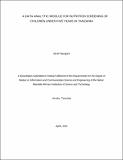| dc.description.abstract | Malnutrition is one of the major health problems in the world, and more prevalent in developing countries. The World Health Organisation (WHO) estimates that malnutrition is associated to half of all deaths of children under five years. In Tanzania it is estimated that 43,000 children die and the government loses up to Tsh. 700 billion annually due to the effects associated with malnutrition. Due to its unbearable consequences several international organisation have initiated collective measures to combat malnutrition. Nutrition screening, the process of identifying whether the child is malnourished or not, is a proven and important step towards malnutrition eradication. Regular and effective nutrition screening allows early malnutrition or risk of malnutrition to be identified and proper treatment and malnutrition management to be effected.
The whole process of nutrition screening and malnutrition management in Tanzania still requires a lot of improvements. The studies show that the nutrition screening is not effective and it is mostly manual. The process includes the use of papers (clinic card) in recording anthropometrics measurement and that Mid Upper Arm Circumference (MUAC) is the only tool used for nutrition screening despite the already identified shortcomings. In this study, a nutrition data analytic module for nutrition screening for children under five years is proposed and developed. The system will have the ability to store child records after the child is registered, perform nutrition screening to identify if the child is well nourished or malnourished, and establish the current state of malnourished child in order to allow appropriate action to be taken by a health worker. Additionally the progress of malnourished child will be established to allow proper malnutrition management. The module has the ability to create reports which will help researchers, stakeholders and other users to get nutrition related data and information and malnutrition trends. This study puts in place a nutritional data analytic module for nutrition screening. This will facilitate effective nutrition screening of children and hence improve children nutrition health. | en_US |

